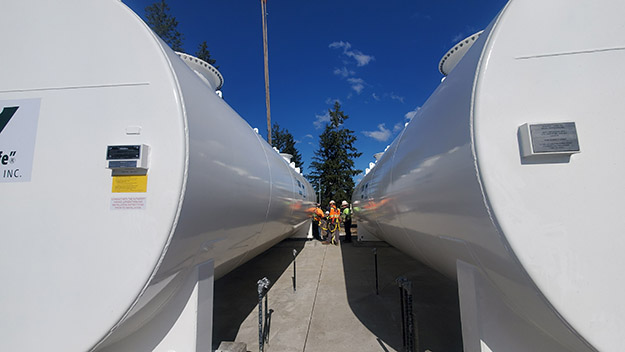JOINT BASE LEWIS-McCHORD - It's a bird, it's a plane. No wait, it's just the new Defense Logistics Agency - Energy's aboveground fuel storage tanks being put into place. There are two new fuel stations coming to Joint Base Lewis-McChord with fuel storage tanks that experts believe will be better for the environment.
"Keeping oil out of the environment is our number one priority," said Cheryl Dunning, Resource Conservation and Recovery Act Compliance Program Manager with the JBLM Directorate of Public Works. "Aboveground fuel storage is much preferred over underground storage.
Two studies have been done on JBLM's fuel infrastructure, the first in 1999 and another in 2011. Following the most recent study from 2011, JBLM officials requested the DLA-E conduct a study for possible optimization options. That optimization study identified two fuel stations with underground fuel storage tanks installed in 1997. Since underground tanks have an average lifespan of around 30 years, the tanks were recommended for an upgrade.
"Aboveground tanks offer many advantages," Dunning said. "Visual inspections to spot leaks or necessary repairs can be done instantly, potential leaks are more easily cleaned up and often less expensive, aboveground tanks generally last longer and they are much easier to maintain and relocate, if needed. As underground fuel storage tanks on JBLM reach the end of their useful lifespans, we are replacing them with aboveground storage tanks whenever possible."
The primary benefit of aboveground fuel tanks is the reduced environmental impact and risk since aboveground tanks and underground tanks can hold petroleum or other hazardous substances. When an underground tank leaks, hazardous materials can seep into the surrounding soil and possibly reach groundwater. Any contaminated soil must be remediated.
Protection of groundwater is very important, as it the source of drinking water for JBLM and surrounding communities. In contrast, with aboveground tanks, spills are easily detected and contained prior to contact with soil.
Other benefits include easier maintenance actions and inspections, and there is not a large digging requirement to install them. For these reasons, the Department of Defense has leaned more often to ASTs in their petroleum facility design.
Construction on JBLM's aboveground stations is expected to be completed by September. Those permitted to use the new facilities won't notice a difference when at the pump, other than the peace of mind knowing these new facilities are protecting the environment.





Read Comments